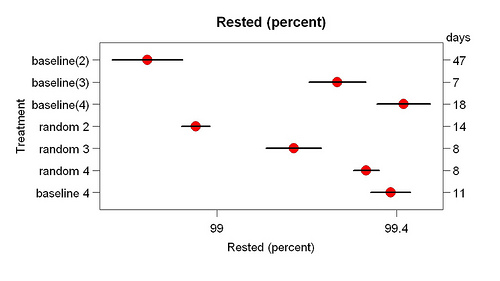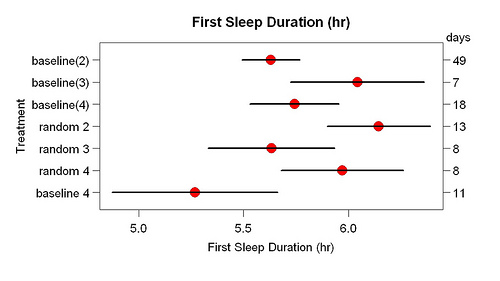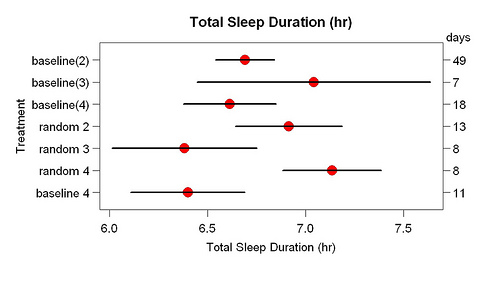In 1996, I accidentally discovered that if I stood a lot I slept better. If I stood 9 hours or more, I woke up feeling incredibly rested. Yet to get any improvement I had to stand at least 8 hours. That wasn’t easy, and after about 9 hours of standing my feet would start to hurt. I stopped standing that much. It was fascinating but not practical.
In 2008, I accidentally discovered that one-legged standing could produce the same effect. If I stood on one leg “to exhaustion” — until it hurt too much to continue — a few times, I woke up feeling more rested, just as had happened when I stood eight hours or more. At first I stood with my leg straight but after a while my legs got so strong it took too long. When I started standing on one bent leg, I could get exhausted in a reasonable length of time (say, 8 minutes), even after many days of doing it.
This was practical. I’ve been doing it ever since I discovered it. A few months ago I decided to try to learn more about the details. I was doing it every day — why not vary what I did and learn more?
One thing I wanted to learn was: how much was best? I would usually do two (one left leg, one right leg) or four (two left leg, two right leg). Was four better than two? What about three?
I decided to do something relatively sophisticated (for me): a randomized experiment. Every morning I would do two stands (one left, one right). In the evening I would randomly choose between zero, one, and two additional one-legged stands. Sometimes I forgot to choose. Here are the results for three sets of days: (a) “baseline” days (baseline(2), baseline(3), baseline(4)) before the randomized experiment and during the experiment when I forgot and (b) the “random” days (random 2, random 3, random 4) when I randomly choose and (c) a later set of days (“baseline 4″) when I did four one-legged stands every day.
Each morning, when I woke up I rated how rested I felt on a scale where 0 = not rested at all (as tired as when I went to sleep), and 100 = completely rested, not tired at all.
 This shows means and standard errors. The number of days in each condition are on the right.
This shows means and standard errors. The number of days in each condition are on the right.
The main results are that three was better than two and four was better than three. The three/four difference was large enough compared to the two/four difference to suggest that five might be better than four. The similarity between random 4 and baseline 4 means that the amount of one-legged standing on previous days doesn’t matter much. For example, on Monday night it doesn’t matter how much I stood on Sunday.
These differences were not reflected in how long I slept. Below are the results for “first” sleep duration, meaning the time from when I went to sleep to when I woke up for the first time — which is when I measured how rested I was (the graph above). On a small fraction of days, I went back to sleep a few hours later.

These results mean that one-legged standing increased how deeply I slept, what you could call sleep “efficiency”.
I also computed “total” sleep duration, which included first sleep duration, second sleep duration, and nap time the previous day (e.g., nap time on Monday plus sleep Monday night). If I took a long nap, I slept less that evening. Here are the results for total sleep duration.

The results also support the idea that one-legged standing made me sleep more deeply.
The randomized experiment had pluses and minuses compared to a simpler design (such as an ABA design, where you do each treatment for several days in a row). The two big pluses were that the conditions being compared were more equal and you could simply continue until the answer was clear. The two big minuses were that I often forgot to do the randomization and lack of realism. If I decided that four was the best choice, I’d do four every day, not in midst of two’s and three’s.
Overall, it was clear beyond any doubt that four was better than two, and clear enough that four was better than three (one-tailed p = 0.02). The results suggest trying larger doses, such as five and six. I’ve only done six once: before a flight from Beijing to San Francisco. It was one of the few long flights where I slept most of the way.
If you try this and you do more than one right and one left, leave plenty of time (two hours?) before the second pair, to allow the signaling molecules to be regenerated.
It is hard for me to understand: I don’t know what you mean by “think of me as rating the amount of a substance that makes me feel tired.” Substance?
My current expectation/belief is that most people would probably struggle to rate their perception of their own restedness on a 1-20 scale to the nearest whole number (ie., to within approx 5%) with much confidence, let alone to within fractions of 1 percent.
Regards.